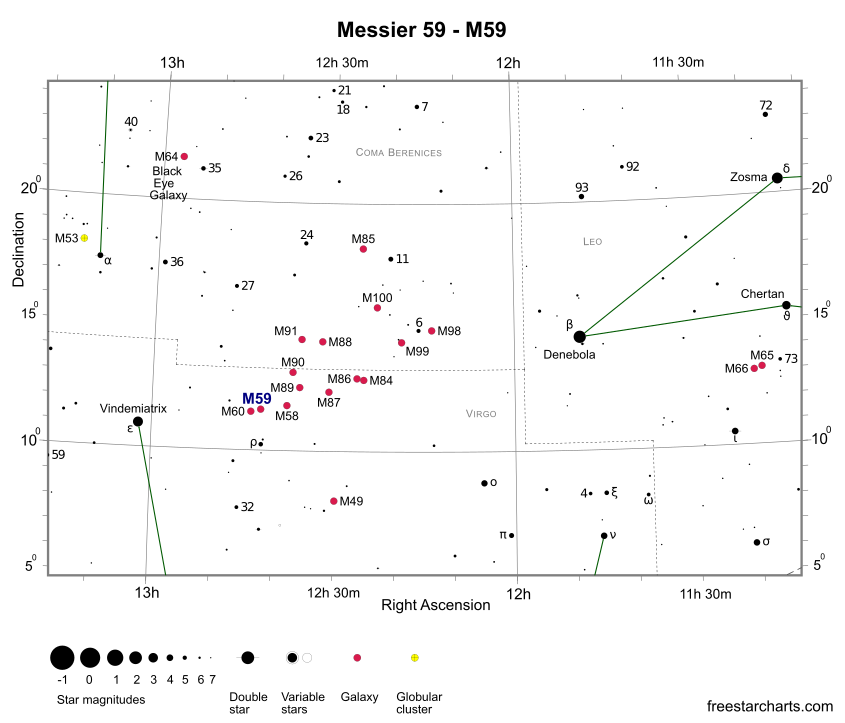M59 is an elliptical galaxy in Virgo and a member of the Virgo cluster. It was discovered by Johann Gottfried Koehler on April 11, 1779 while observing a comet in the same region of sky. On that day he also discovered neighbouring galaxy M60, which is a slightly larger and brighter version of M59. Also comet chasing at the same time was Charles Messier, who independently found both galaxies four days later. During his search, Messier discovered M58 which was missed by Koehler. Of the three galaxies, Messier described M60 as the brightest with M59 and M58 slightly fainter but of similar magnitudes.
At apparent magnitude +9.8, M59 is a challenging small telescope object. It can be spotted with 80mm (3.1-inch) scopes or even large binoculars, but dark skies are a must. Even then it only appears as a faint patch and is really an object for larger amateur instruments. The galaxy is located 60 Million light-years away and exhibits an apparent size of 5.4 x 3.7 arc minutes, which corresponds to a spatial diameter of 95,000 light-years. Despite been one of the largest elliptical galaxies in the cluster, M59 is considerably less massive and less luminous than other great ellipticals, such as M49, M60 and M87.
A good proportion of the Messier Virgo Cluster galaxies can be found along or near an imaginary line connecting Denebola (β Leo - mag. +2.1) with Vindemiatrix (ε Vir - mag. +2.8). M59 is no exception and it's positioned almost 5 degrees due west of Vindemiatrix. Located 0.4 degrees east of M59 is M60, with M58 one degree west of M59.
The galaxies are best seen during the months of March, April and May.


Finder Chart for M59 - pdf format (credit:- freestarcharts)
When viewed through medium 150mm (6-inch) or 200mm (8-inch) aperture scopes, M59 appears as an elongated diffuse patch of light. The central core is condensed and bright with a large faint nebulous halo surrounding it. Through the eyepiece, M59 looks slightly smaller and fainter than M60, but otherwise rather similar in appearance. Both galaxies are visible in the same low power eyepiece field of view.
In total, M59 contains somewhere between 1,500 and 2,400 globular clusters. This is considerably less than the number found in M49, M60 and M87, but still ten times more than in our own Milky Way Galaxy. To date, only one supernova has been recorded in M59 (1939B). It peaked in 1939 at magnitude +11.9.
M59 Data Table
| Messier | 59 |
|---|---|
| NGC | 4621 |
| Object Type | Elliptical galaxy |
| Classification | E5 |
| Constellation | Virgo |
| Distance (light-years) | 60 Million |
| Apparent Mag. | +9.8 |
| RA (J2000) | 12h 42m 02s |
| DEC (J2000) | +11d 38m 48s |
| Apparent Size (arc mins) | 5.4 x 3.7 |
| Radius (light-years) | 47,500 |
| Number of Stars | 200 Billion |
| Notable Feature | Member of the Virgo Cluster of galaxies |